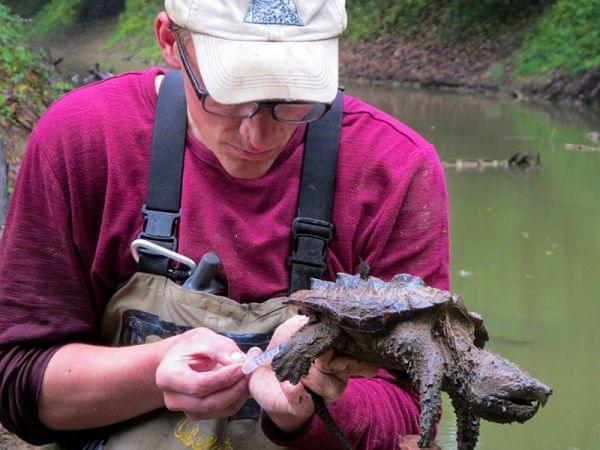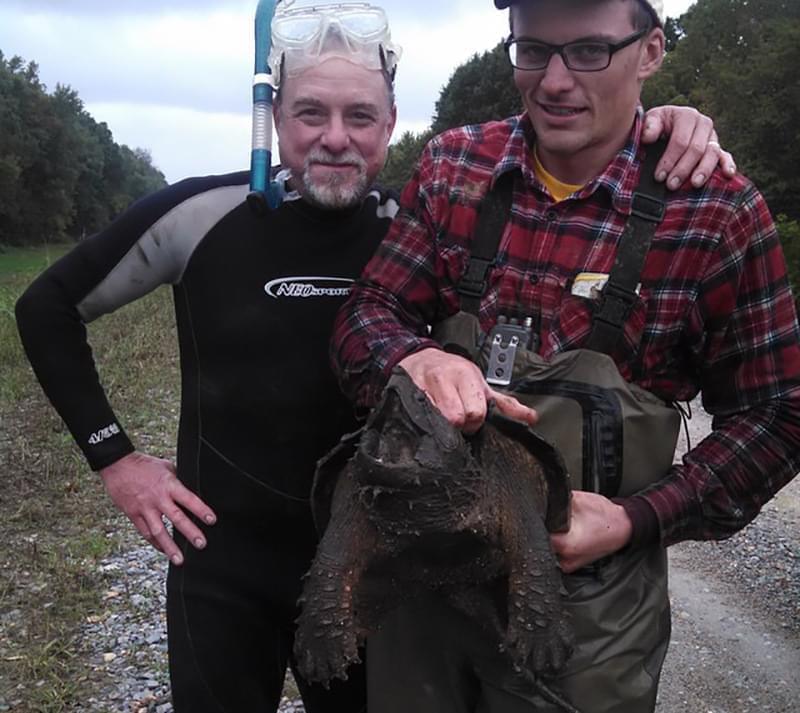Alligator snapping turtles reintroduced in southern Illinois

Ethan Kessler draws blood from an alligator snapping turtle just before releasing it Eva Kwiatek
If you’ve ever seen a snapping turtle in Illinois, it was almost certainly a “common snapping turtle.” Common snappers can be found throughout the state, and they’re able to adjust to life in nearly any body of water. This commentary is not about common snapping turtles. It’s about alligator snapping turtles, which are bigger, gnarlier southern cousins of common snapping turtles.
Alligator snappers are distinguished by three ridges of spines on their upper shell and a head that looks huge in proportion to their body. They also have a wicked hooked beak. And they get big, too, bigger than any other freshwater turtle in North America, with top weights in the wild reaching 155 pounds.
Alligator snappers prefer life in large rivers like the Mississippi, Ohio and Wabash or waters directly connected to them. So they were never widespread in Illinois, which also marks the northern limit of their range. Over the course of the twentieth century, alligator snapping turtle populations in the state were wiped out entirely by habitat alteration and overharvesting. But favorable conditions now exist in enough places to make reintroducing them feasible.
I spoke recently about a project to do just that with two of the people at its forefront, Mike Dreslik, a herpetologist with Illinois Natural History Survey (INHS) in Champaign, and Ethan Kessler, who is working toward a master’s degree in the Department of Natural Resources and Environmental Sciences at the U of I, with Dreslik as his adviser. Here’s what I learned from them.
The current reintroduction, which involves collaboration with multiple other state and federal agencies, as well as the St. Louis and Peoria zoos, involves a long-term effort. That’s because alligator snapping turtles are long-lived creatures, and they don’t reach sexual maturity until they’re 11 or more years old.
This summer Dreslik, Kessler and others released a total of 97 alligator snapping turtles in a creek at the southwestern edge of the state. To say those turtles were released, though, tells only a small piece of the story. On the day they were let go, every one got a health checkup, which included a visual exam and blood work. They were also fitted with tiny data loggers that record water temperature, and 62 them had radio transmitters attached to their shells.
With the help of those transmitters, Kessler and company relocated each turtle three times a week through the rest of the field season. Partly this was to keep tabs on the health of the turtles and to see whether they were competent at life in the wild, since nearly all of them were reared in aquariums at hatcheries or zoos. Happily, they really were and only one of the turtles with a radio transmitter died this year.
Additionally, the information gathered in relocating them will help scientists answer important questions about habitat preferences and movements. The surprise on this front came from the biggest of the released turtles, a 16-pounder. He immediately moved nearly a mile upstream to a big logjam, where he then stayed put for the rest of the season.
The answers to questions about movements and habitat preference will, in turn, help to answer a broader one, which has implications for the prospects of other endangered turtle species as well. As Dreslik summed it up, “How do we reintroduce turtles to the wild with the greatest chance of success?”

INHS herpetologist Chris Phillips and graduate student Ethan Kessler with a native Illinois alligator snapper
For now, though, the more pressing concern about Illinois’ new alligator snappers is how well they cope with winter. We’ll check back next spring to see.
Bonus turtle:
Explaining this as part of the radio commentary got too convoluted so I left it out there. But INHS herpetologist Chris Phillips came up with a real surprise as he was groping around in deep, murky water to find one of the turtles with a radio transmitter; he found a wild alligator snapping turtle, the first one in the state since 1984.
As to what exactly that means, the jury is still out. But given the amount of time and effort that has gone into looking for alligator snapping turtles, no one I spoke with was inclined to take it as evidence of some hidden, viable population.

